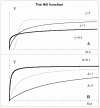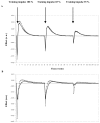Modeling the residual effects and threshold saturation of training: a case study of Olympic swimmers
- PMID: 15705048
- PMCID: PMC5352828
- DOI: 10.1519/14853.1
Modeling the residual effects and threshold saturation of training: a case study of Olympic swimmers
Abstract
The aim of this study was to model the residual effects of training on the swimming performance and to compare a model that includes threshold saturation (MM) with the Banister model (BM). Seven Olympic swimmers were studied over a period of 4 +/- 2 years. For 3 training loads (low-intensity w(LIT), high-intensity w(HIT), and strength training w(ST)), 3 residual training effects were determined: short-term (STE) during the taper phase (i.e., 3 weeks before the performance [weeks 0, 1, and 2]), intermediate-term (ITE) during the intensity phase (weeks 3, 4, and 5), and long-term (LTE) during the volume phase (weeks 6, 7, and 8). ITE and LTE were positive for w(HIT) and w(LIT), respectively (p < 0.05). Low-intensity training load during taper was related to performances by a parabolic relationship (p < 0.05). Different quality measures indicated that MM compares favorably with BM. Identifying individual training thresholds may help individualize the distribution of training loads.
Figures




References
-
- Ali MA. Effect of sample size on the size of the coefficient of determination in simple linear regression. J Inform Optim Sci. 1987;8:209–219.
-
- American College of Sports Medicine. Progression models in resistance training for healthy adults. Med Sci Sport Exerc. 2002;34:364–380. - PubMed
-
- Banister EW, Calvert TW, Savage MV. A systems model of training for athletic performance. Can J Sports Med. 1975;7:57–61.
-
- Banister EW, Carter JB, Zarcadas PC. Training theory and taper: validation in triathlon athletes. Eur J Appl Physiol. 1999;79:182–191. - PubMed
MeSH terms
LinkOut - more resources
Full Text Sources
Research Materials
